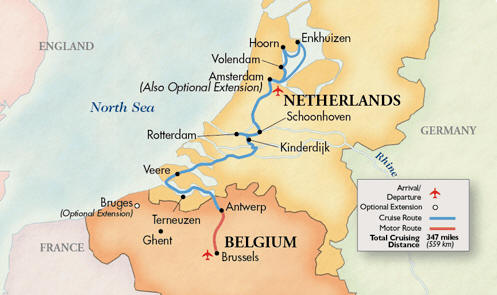|
|||
|
|
|||
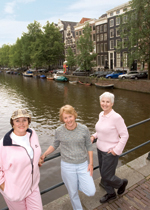 |
Amsterdam Arrive today in the Dutch capital, where you'll be greeted at the airport and transferred to your ship to meet up with those who took our optional pre-trip extensions to Amsterdam, the Netherlands or Berlin, Germany. After an included light lunch, relax aboard ship or take a stroll around the neighborhood where it's docked. In the late afternoon, gather in the lounge for an informative ship embarkation and safety meeting, followed by dinner onboard. |
||
|
|
|||
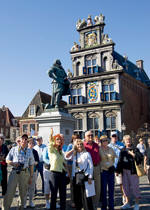 |
Hoorn After breakfast, disembark for a walking tour of Hoorn, once one of Holland's richest port cities. After lunch, enjoy some time at leisure to explore the city, the main market town for the West-Friesland region. Once the headquarters of the Dutch East India Company, Hoorn dates back to 1357 and its history will be on abundant display as you walk its lanes. |
||
|
|
|||
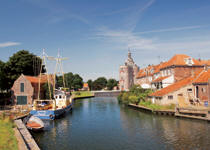 |
Enkhuizen Enjoy breakfast as you sail this morning from Hoorn to Enkhuizen, a striking, magnificently preserved town established between AD 1000 and AD 1200. This morning you'll enjoy a walking tour of Enkhuizen, which became a city in 1355, prospering due to its herring fishing industry and trade from the East and West India Companies. Enkhuizen reached its peak in the 17th century when it boasted the largest herring fleet in Holland. The thriving port sat on the edge of the Zuider Zee, an inlet of the North Sea until it was enclosed in 1932. Now, Enkhuizen sits on the Ijsselmeer, the large inland lake created by the damming of the sea outlet. With a population of about 16,000, this historic city retains its old charms, and its harbors attract thousands of pleasure boats. You'll also see the Drommedaris, an old defense tower at the entrance to the harbor and the many warehouses originally used by both the East and West India Company. Enjoy free time and lunch onboard before walking to the home of a local family who'll be your hosts for coffee, cake, and conversation. Along with an eye-opening intercultural exchange, you might enjoy a stroopwafel - a thin, waffle-like cookie sandwich with a sweet, chewy center. |
||
|
|
|||
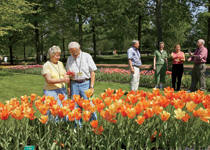 |
Keukenhof Flower Park You'll enjoy a morning of sailing, then enjoy lunch aboard ship before setting off on a true "Netherlands in Springtime" experience. Board your motorcoach and ride to the Keukenhof Flower Park in the heart of western Netherlands' tulip-growing region. You'll have the opportunity to stroll through the park - 70 acres of lovely, tree-shaded grounds with ponds, winding paths, streams, and fountains. Once the kitchen garden of a medieval castle, today it is known as the "greatest flower show on Earth," featuring more than seven million tulips and a variety of other flowers. We continue our afternoon with a visit a tulip farm, an exclusive Discovery Series event. The Netherlands have more than 23,000 acres set aside for the cultivation of their famous blooms, and during the spring season, the area's landscape is rich with vibrant colors as the tulips come to life. During your visit, you'll see these brightly colored flowers, and learn how farmers prepare the tulips to be picked and sold. |
||
|
|
|||
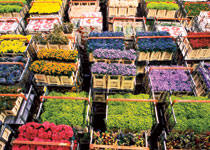 |
Aalsmeer Flower Auction Early this morning, immerse yourself in the spectacle of the Aalsmeer Flower Auction (the world's largest). Holland produces more than nine billion flower bulbs annually, and throughout the country more than 23,000 acres of land are dedicated to greenhouse production. In Aalsmeer, the auction house itself comprises about 160 acres. Stationed at the visitors' gallery, you'll witness buyers from all over the world making deals at a lightning pace. Each day more than 19 million fresh flowers are sold during a computerized auction. As the clock for a group of flowers to be auctioned ticks down, the price lowers with it. Bidders bid by pressing a button (which is linked to the main computer) when the price of the flowers reaches what they are willing to pay - if someone else hasn't pressed his button first. So there is only one bid: the highest. Once purchased here, they are loaded onto airplanes and transported to florist shops across Europe and the U.S., usually to be sold the same day. Back in Amsterdam we embark on a local canal boat for tour of its canals. During your tour, you'll view Amsterdam's landmarks, such as the 17th-century Royal Palace and the Mint Tower, which has retained its name even though gold and silver coins were minted here for only a couple of years. Along the waterways of this UNESCO World Heritage Site, you'll also see the wooden double drawbridge, known as the "Skinny Bridge," that may remind you of Van Gogh's paintings. |
||
|
|
|||
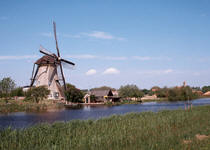 |
Kinderdijk This morning, you head for Kinderdijk to tour the windmills that have made this city a UNESCO World Heritage site. Kinderdijk takes its name from a 16th-century legend involving a baby (or kinder), a cradle, and a cat that all survived being tossed into raging waters. For centuries, the Dutch were at the mercy of frequent floods. Around 1740, 19 windmills were built in the village of Kinderdijk. These innovative structures drain the excess water from polders - the reclaimed land that is situated below sea level - and pump it into nearby rivers and canals. This helps to evenly distribute water levels and lessen the threat of devastating floods. Nowadays, modern engines do the job of turning the paddle wheels, forcing them to scoop up the water, yet the country still has a unique bond with, and affection for, its many windmills. The windmills have been well-preserved, and the historic structures - supported in part by Grand Circle Foundation - became protected by UNESCO in 1997. You'll walk to the famed windmills and have time at the site to take some photos of these nostalgic, yet pragmatic creations. The afternoon is at leisure. Or join us for an optional Gouda tour. In an hour-long walking tour of Gouda with a local guide, you'll get to know the city from a new perspective, then enjoy time on your own to explore. Along the way, you'll sample the cheese for which the town is well-known. |
||
|
|
|||
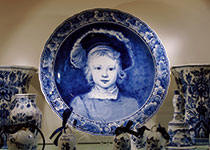 |
This morning, discover Rotterdam on an included walking tour, followed by free time on your own. Or join us for a Delft optional tour. Dating to the 13th century, Delft was a long-time home port to the Dutch East India Company. It is well-known for its blue and white pottery called Delftware, which was first produced in the 17th century and styled after imported Chinese porcelain. You'll learn more about the unique pottery during a visit to a local porcelain factory. You'll also enjoy a guided walking tour of the city. This afternoon, explore at your own pace, or join the included walking tour of Rotterdam for those who enjoyed our morning Optional Delft tour. |
||
|
|
|||
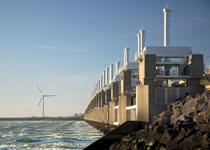 |
Delta Works After breakfast on board, disembark at Veere, where you'll get to know this picturesque village during a morning stroll. Your Program Director will share information about this artist-friendly town of 1,500 and its past as a walled trading city in the Middle Ages. Enjoy free time here before returning to your ship for lunch onboard. Or, join an optional excursion to the Delta Works, an engineering marvel designed to protect Holland from floods. Terrible floods in 1953 made clear that low-lying Holland, ever at the mercy of flooding, needed a plan to protect itself from future weather events. Over the next 40 years, a complex plan led to the damming of four major estuaries, and the coordination of an extensive network of locks, sluices, channels, bridges, and gates. You'll learn about this challenge in a film at the site and free time to explore. Then, we'll take in the final step of the Delta Works plan, the Storm Surge Barrier, comprised of two huge doors which can close off the New Waterway in times of extreme weather. |
||
|
|
|||
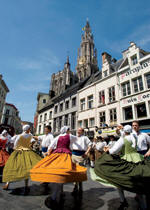 |
Antwerp After breakfast, set off on a walking tour of Antwerp. Located on the banks of the Schelde River, Antwerp is Belgium's major port and has been commercially important in European trade since the eleventh century. Like Amsterdam, it is one of the world centers for diamond trading. In spite of damage suffered during both World Wars, Antwerp remains a city of beautiful historic architecture dating to the 16th century. You'll explore Antwerp's well-preserved Old Town, built around the Grote Markt (Town Square), and graced by the lovely old Town Hall and beautiful guild houses. Marvel at the elegant spires of the Cathedral of Our Lady, graced with masterpieces by the great painter Peter Paul Rubens who lived here in the 17th century. Stroll along the Meir (Antwerp's main shopping street), lined with wonderfully elaborate historic buildings. |
||
|
|
|||
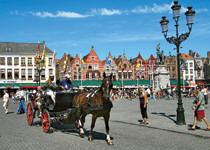 |
Bruges, Belgium One of Western Europe's greatest medieval cities. Originally a ninth-century fortress built to protect the Flemish coast from marauding Vikings, Bruges today retains its reputation as one of the best-preserved Old World cities on the continent. Its museums hold some of the oldest and finest collections you will find anywhere, and its narrow, winding streets meander through the city beside a centuries-old canal system. |
||
|
|
|||
|
|
Updated 5/29/15 |
||
